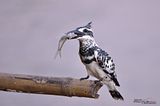Few weeks ago, there was a Great Crested Grebe (Podiceps cristatus) influx around my dorm. I once counted 26 birds in one group and there were also many others scattering in the sea and small ports. Most of them didn't let me get close as usual, but I found 1 individual in a small port in Kyomachi that was obliging enough for me to get some decent shots at close range. Several days later, the number of the individuals in that port increased to the maximum of 7 birds. However, all of them has recently disappeared from the port after the weather has worsened. I just hope that they'd come back again and stay until they fully moult into their beautiful breeding plumage.





Great Crested Grebe (Podiceps cristatus) in non-breeding plumage









At first it was not easy to get close to the bird at all, since it kept staying in the middle of the port once it saw me. I sat and waited until the tide became lower and the bird seemed to become more interested in feeding along one of the shallow corners where it caught quite many small fish. I used the same technique that I've always used when trying to photograph birds that like to dive, which was running further as the bird begins to dive and stopping at a spot where the bird is likely to pop up from underneath. This technique mostly works since the birds wouldn't be able to see us when they're diving, so we can move freely to the point where they're assumed to appear again. However, some birds like the Pacific Loon in this post, are exceptional since they can dive for a longer period of time and the places where they pop up are totally random.








Great Crested Grebe (Podiceps cristatus) in non-breeding plumage



I was able to observe an interesting behaviour of the Black-tailed and Vega Gull. The gulls seemed to favour staying closely to the grebe. I was wondering why they always seemed to follow the grebe around until I finally realised that they were trying to steal the fish that the grebe caught. I didn't see them successfully taking any fish from the grebe though, since the grebe could always dive into the water. Sometimes the harassment seemed very serious but the grebe could always get away from the gulls. Few days later I didn't see the gulls following around the grebes anymore.





















4 comments:
Not only piracy- I've seen Gulls kill and eat Black Necked Grebes before.....
Stunning photographs and fantastic documenting the behaviours. I've only been briefly surprised by close encounters with these guys and like that, they dive and go away. Love the colours you have down there. better than grey all days.
This grebe species is certainly beautiful and graceful. Most unfortunate it does not occur in Malaysian waters. Great shots and documentation.
Test Post hello hello
Post a Comment